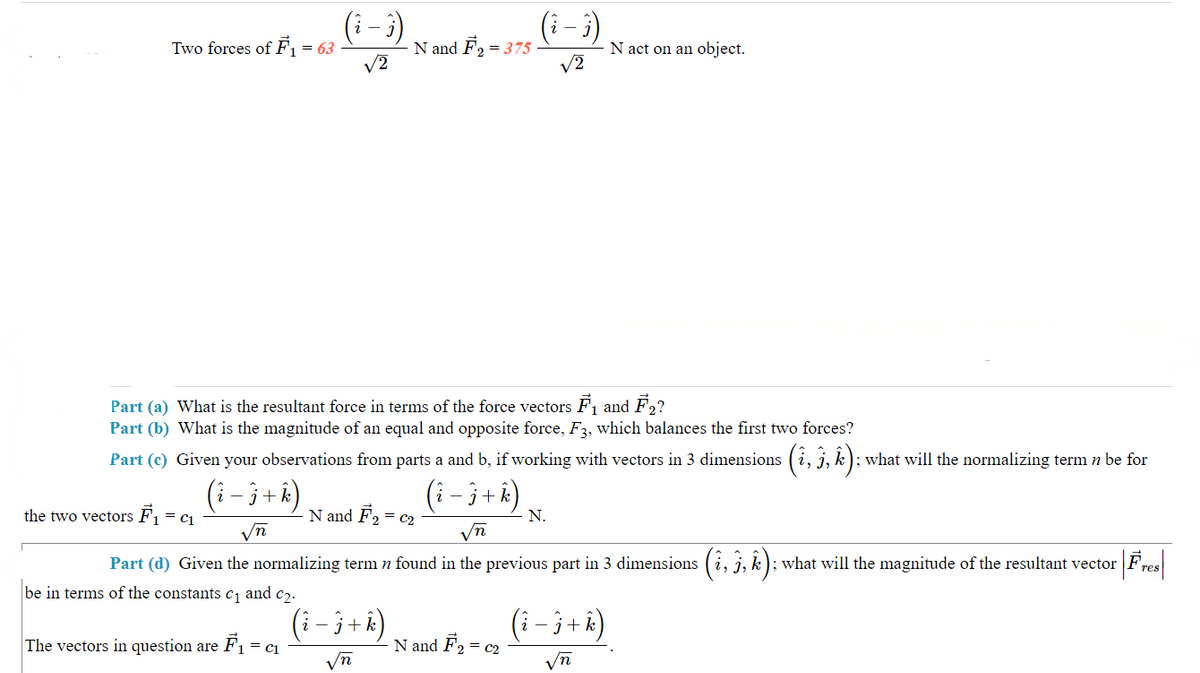Two forces of F₁ = = 63 Part (c) Given your obse (i-3+k) √n the two vectors F₁ = C1 (₁ - i) √2 Part (a) What is the resultant force in terms of the force vectors F₁ and F₂? Part (b) What is the magnitude of an equal and opposite force, F3, which balances the first two forces? The vectors in question are F₁ = C₁ N and F₂ = -N and F₂ = C₂ = 375 + √√n from parts a and b, if working with vectors in 3 dimensions (2, 3, k); what will the normalizing term n be for (i- j + k) √2 √n Part (d) Given the normalizing term n found in the previous part in 3 dimensions (i, j, k);v ; what will the magnitude of the resultant vector Fres be in terms of the constants c₁ and c₂. (î N. -N and F₂ = c₂ N act on an object. (i-3+k) √n
Two forces of F₁ = = 63 Part (c) Given your obse (i-3+k) √n the two vectors F₁ = C1 (₁ - i) √2 Part (a) What is the resultant force in terms of the force vectors F₁ and F₂? Part (b) What is the magnitude of an equal and opposite force, F3, which balances the first two forces? The vectors in question are F₁ = C₁ N and F₂ = -N and F₂ = C₂ = 375 + √√n from parts a and b, if working with vectors in 3 dimensions (2, 3, k); what will the normalizing term n be for (i- j + k) √2 √n Part (d) Given the normalizing term n found in the previous part in 3 dimensions (i, j, k);v ; what will the magnitude of the resultant vector Fres be in terms of the constants c₁ and c₂. (î N. -N and F₂ = c₂ N act on an object. (i-3+k) √n
University Physics Volume 1
18th Edition
ISBN:9781938168277
Author:William Moebs, Samuel J. Ling, Jeff Sanny
Publisher:William Moebs, Samuel J. Ling, Jeff Sanny
Chapter2: Vectors
Section: Chapter Questions
Problem 26P: In a tug-of-war game on one campus, 15 students pull on a rope at both ends in an effort to displace...
Related questions
Concept explainers
Rotational Equilibrium And Rotational Dynamics
In physics, the state of balance between the forces and the dynamics of motion is called the equilibrium state. The balance between various forces acting on a system in a rotational motion is called rotational equilibrium or rotational dynamics.
Equilibrium of Forces
The tension created on one body during push or pull is known as force.
Question
Please circle answers

Transcribed Image Text:Two forces of F₁ = = 63
the two vectors F₁ = C₁
√2
= C1
The vectors in question are F₁ =
N and F₂ =
Part (a) What is the resultant force in terms of the force vectors F₁ and F2?
Part (b) What is the magnitude of an equal and opposite force, F3, which balances the first two forces?
Part (c) Given your observations from parts a and b, if working with vectors in 3 dimensions (î, 3, k); what will the normalizing term n be for
(i - j + k)
( i − j + k)
N and F2₂ = C2₂
= 375
- j + k)
In
(₁ - i)
√2
√n
n
Part (d) Given the normalizing term n found in the previous part in 3 dimensions (i, j, k); what will the magnitude of the resultant vector
:| Fres
be in terms of the constants c₁ and c₂.
N and F₂ = c₂
- N.
N act on an object.
(i-j+ k)
√n
Expert Solution
This question has been solved!
Explore an expertly crafted, step-by-step solution for a thorough understanding of key concepts.
Step by step
Solved in 3 steps with 2 images

Knowledge Booster
Learn more about
Need a deep-dive on the concept behind this application? Look no further. Learn more about this topic, physics and related others by exploring similar questions and additional content below.Recommended textbooks for you

University Physics Volume 1
Physics
ISBN:
9781938168277
Author:
William Moebs, Samuel J. Ling, Jeff Sanny
Publisher:
OpenStax - Rice University

Principles of Physics: A Calculus-Based Text
Physics
ISBN:
9781133104261
Author:
Raymond A. Serway, John W. Jewett
Publisher:
Cengage Learning

Physics for Scientists and Engineers
Physics
ISBN:
9781337553278
Author:
Raymond A. Serway, John W. Jewett
Publisher:
Cengage Learning

University Physics Volume 1
Physics
ISBN:
9781938168277
Author:
William Moebs, Samuel J. Ling, Jeff Sanny
Publisher:
OpenStax - Rice University

Principles of Physics: A Calculus-Based Text
Physics
ISBN:
9781133104261
Author:
Raymond A. Serway, John W. Jewett
Publisher:
Cengage Learning

Physics for Scientists and Engineers
Physics
ISBN:
9781337553278
Author:
Raymond A. Serway, John W. Jewett
Publisher:
Cengage Learning

Physics for Scientists and Engineers with Modern …
Physics
ISBN:
9781337553292
Author:
Raymond A. Serway, John W. Jewett
Publisher:
Cengage Learning

Glencoe Physics: Principles and Problems, Student…
Physics
ISBN:
9780078807213
Author:
Paul W. Zitzewitz
Publisher:
Glencoe/McGraw-Hill